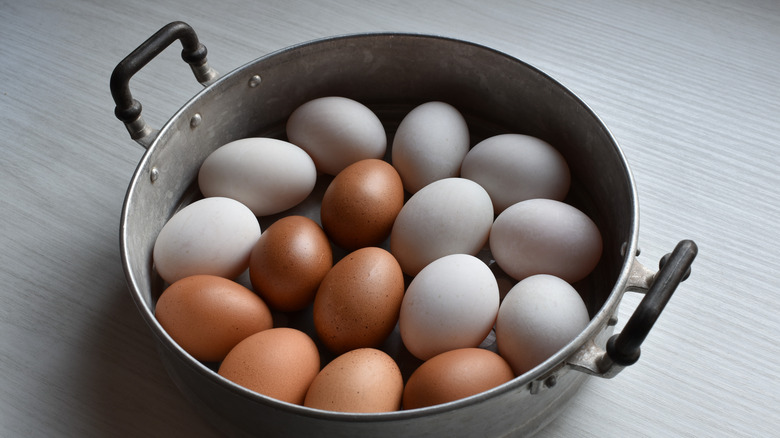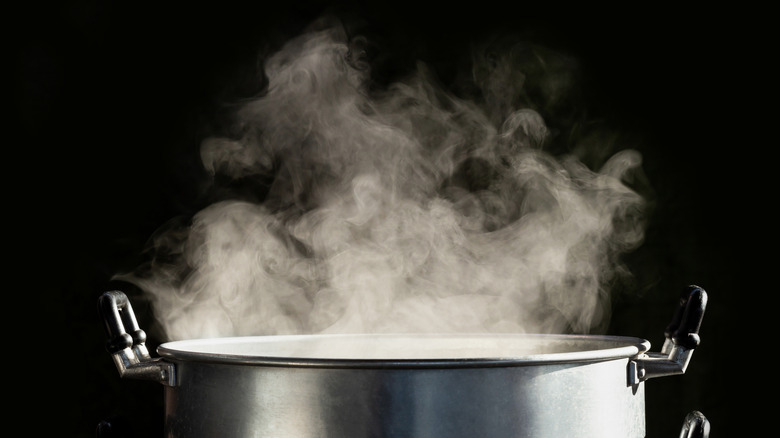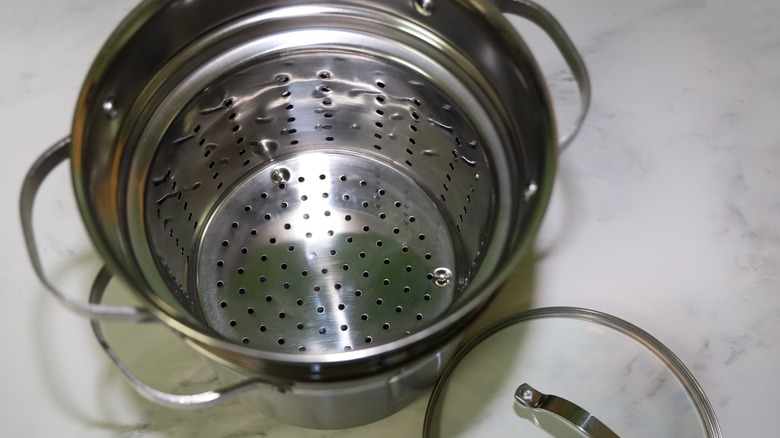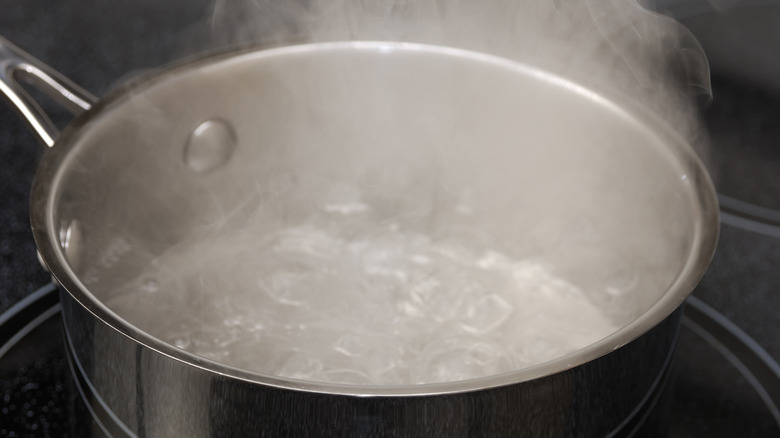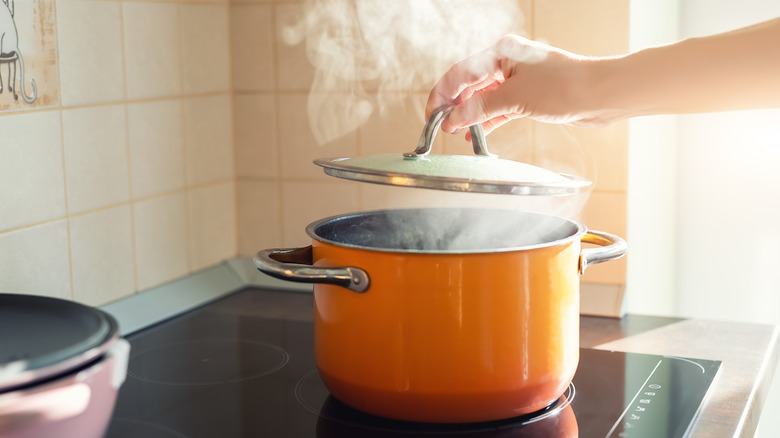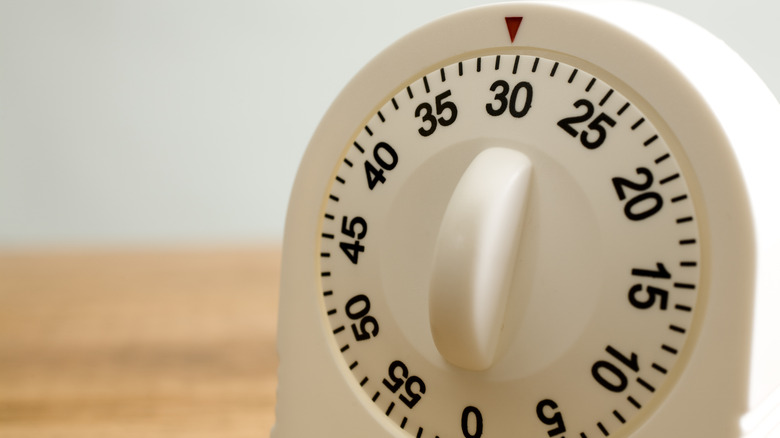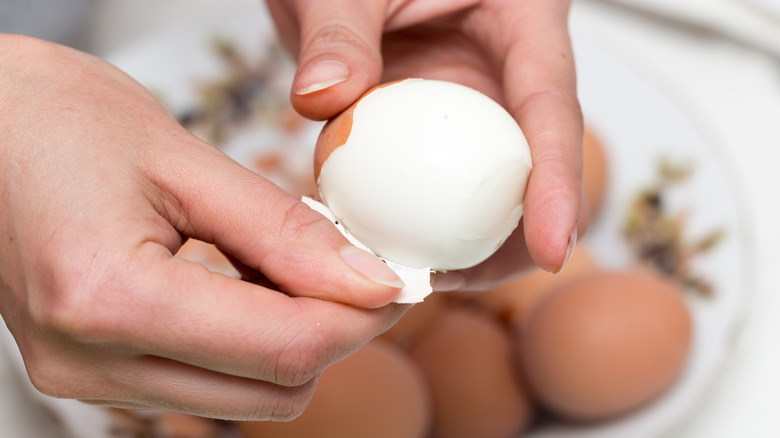7 Tips You Need When Steaming Eggs
Eggs are a deceptively simple food to cook. Boiling, scrambling, and frying all sound like easy ways to prepare eggs, but cooking them perfectly can be tricky because they're a delicate food, and the most common ways to prepare them are harsh. You're either adding cracked eggs to a hot pan or boiling them in their shell. The goal is to make scrambled eggs that are soft and boiled eggs without the dark green ring around the yolk that appears when they're overcooked.
There are numerous tricks recommended to make boiling the perfect egg easy. Starting with room-temperature eggs, adding baking soda to the water, placing the eggs in a pot with cold water, and placing the eggs in a pot with boiling water are hacks that may or may not be effective. But the easiest way to get perfectly boiled eggs every time is to steam them.
Instead of cooking eggs in rapidly boiling water, steaming eggs harnesses the power of the steam produced by the boiling water to cook the eggs gently. This gentle cooking process produces eggs with tender whites and creamy yolks. Steaming cooks the eggs at a constant temperature without the temperature fluctuations that can accompany boiling. You get a consistent temperature that allows you to cook your eggs to the exact level of doneness you prefer.
Whether you like your eggs with a soft, runny center or a moist, firm yolk, steaming is the way to go.
Use the right amount of water
Steaming is not a cooking method with a lot of rules to follow for success. Unlike baking, where a recipe must be followed to the letter in order for it to work correctly, steaming is a more casual approach to cooking. That doesn't mean there aren't standard operating procedures involved to ensure steaming success. Using the right amount of water when you steam food is one important factor you don't want to get wrong.
Food should never touch the water when steamed. Instead, food should sit just above the water's surface to ensure a steady cooking temperature. The trick is adding enough water to produce enough steam to last throughout your cooking time. You also need to make sure the water doesn't touch the eggs.
Adding too little water will result in the water evaporating before your eggs are thoroughly cooked. The time it takes you to add more water and wait for it to come to a boil will result in unevenly cooked eggs, or even overcooked eggs. If you add too much water and it causes the eggs to be even partially covered in water, you are likely to end up with eggs that are overcooked.
For best results, there should be about 1 to 2 inches between the water's surface and the bottom of your steaming basket.
Choose the right tools
It's essential to gather the appropriate tools when you're working in the kitchen. You can't grate cheese without a grater or whip egg whites without a whisk. Whether you're baking a cake, grilling a steak, or roasting vegetables, using the right equipment is critical to achieving the best results. Steaming eggs is no different.
The first item you need to steam eggs is a pot large enough to hold the number of eggs you want to cook. A deeper pot is your best option. Shallow pans won't allow room for your steamer basket or your eggs. A heavy-bottomed pot will circulate heat evenly.
A steamer basket makes steaming easy. It fits inside your pot without touching the bottom of the pan and prevents the eggs from being tossed about by the boiling water. If you don't have a steamer insert, you can MacGyver one by balling aluminum foil up and putting it in the bottom of your pan. Place a heat-proof plate on top of the foil and put your eggs on the plate. You can also use a heat-proof colander for steaming. Nestle the colander in your pot, making sure the bottom doesn't touch the water's surface, and place the eggs inside the colander.
It's important to have a timer on hand and dry kitchen towels to remove the hot steamer insert from the pot when you're done, as well as tongs or a ladle to handle the hot eggs.
Wait for a boil
We've all heard the adage about watched pots never boiling, and while that's technically not true — the water will boil eventually — you will need the patience to wait for your water to come to a complete boil before steaming your eggs. Adding them before the boil extends the cooking time, which will result in overcooked eggs.
You've likely seen many recipes that direct you to bring water to a boil before simmering by lowering the heat. That's because there is a significant difference between boiling and simmering, and it's important that you boil, not simmer, the water when steaming. Simmering produces tiny bubbles, usually around the edges of the water's surface. Boiling creates larger bubbles that appear to roll across the surface of the water. You need a big, rolling boil in your pot in order to generate the steam you need to cook your eggs. You won't get that steam with a simmer.
Add water to your pot, put your steamer insert in place, and cover the pot until the water boils. Then it's safe to add your eggs for an ideal steam. Waiting for the boil helps you keep track of exactly how long your eggs are at the correct temperature. You can speed things up by covering the pot as it heats.
Cover the pot tightly
Steaming eggs involves more than placing eggs in a pot of boiling water. The steam is essential, and if it's allowed to evaporate away, your eggs won't cook evenly or thoroughly. You need to trap the steam inside the pot with a tight-fitting lid.
With a lid in place, the steam has no escape. It surrounds the eggs and cooks them quickly and evenly. This is one reason why it's imperative that the eggs sit above the water in the steamer insert, to make it easier for the steam to move freely around the eggs. Be careful not to add too many eggs to your steamer insert. If the eggs touch the lid, it can prevent the steam from circulating evenly around them.
Resist the temptation to remove the lid while steaming eggs. Allowing the steam to escape lowers the temperature in the pot, which will directly affect how well your eggs cook. Addressing one of the mistakes everyone makes when steaming food, culinary scientist and author Jessica Gavin noted that steaming will heat food quickly, so there's no need to check the food as it cooks. This is especially true for eggs. There's no way to check their progress through the shell, so it's best to leave the lid in place.
If you don't have a lid that fits your pot snugly, cover the pot with heavy-duty aluminum foil and use oven mitts or a dry kitchen towel to press the foil tightly into place.
Watch the time
Steaming relies on moist heat to cook food, and moist heat cooking methods are popular in part because they make it difficult to overcook food. The moisture keeps most foods tender, not dry and tough like food cooked too long with other methods. With eggs, utilizing the power of the steam creates an environment with a high temperature that remains constant throughout cooking. This constant heat makes it possible to steam eggs quickly and precisely to your desired degree of doneness, whether that's a soft-boiled egg with a creamy yolk or a hard-boiled egg with a solid center.
It is possible to overcook eggs when they're steamed, especially if you're a runny yolk lover, so paying attention to the time is essential. Use a kitchen timer or your phone to set an alarm to remind you to get your eggs out of the pot, because steaming eggs for too long can cause you to miss the window for your perfect degree of doneness.
For an egg with a fully cooked yolk, place the eggs in your steamer insert once the water has come to a full boil. Cover the pan tightly and cook the eggs for 12-15 minutes without removing the lid. Follow the same procedure for soft-boiled eggs, but they only need six minutes of steaming.
Always use a water bath
Time and temperature are key factors to pay attention to when steaming eggs. The temperature of the steam is steady throughout the cooking process. When food is hot, whether from being roasted in an oven or steamed on your stovetop, it will maintain its temperature even after it's removed from the heat source. This is called carryover cooking.
The heat from the oven or the steam carries over even after the heat is turned off or when the eggs are removed from the pot, in the case of steamed eggs. Carryover cooking can lead to overcooking foods with specific cooking times. A few minutes more of additional cooking time can make the difference between a runny or soft yolk. This is why an ice bath is so important for perfect eggs.
Using an ice water bath is non-negotiable when steaming eggs. It cools the eggs down immediately, stopping the carryover cooking in its tracks. While your eggs are steaming, fill a large bowl with ice and cold water. When your eggs are done, use a slotted spoon or tongs to carefully remove them from the pot and gently place them in the bowl of ice water. Let the eggs sit in the water until they're cool enough to handle, about 15 minutes.
Peel carefully
In addition to perfectly cooked eggs that are tender and delicious, another bonus of steaming eggs is easy peeling. Steaming eggs and losing chunks of the whites as you peel them is disappointing, but there are steps you can take to ensure your steamed eggs don't look like they've already been chewed on.
When eggs are steamed, steam builds up inside the egg. This creates a separation between the shell and the thin, white membrane inside the egg that surrounds the egg white. This separation is what keeps the shell from sticking to the egg white, making it easier to peel eggs in record time. Eggs cooked from the start with cold water don't benefit from the steam buildup, making the shell more likely to stick during peeling.
An ice-water bath can also make steamed eggs easier to peel. When the eggs are fresh from the pot, the whites and yolk are not fully set. Shocking them in ice water causes the egg to set, and it's easier to peel the shell from an egg with a firm white.
To peel your steamed eggs, remove them from the ice water bath. Crack one end of the egg on a hard surface, then roll the egg on your surface with the palm of your hand, applying enough gentle pressure to crack the surface of the shell all over. Gently peel the shell away from the egg, holding the egg under cold running water to help loosen the shell.
